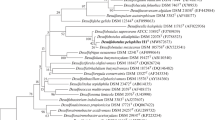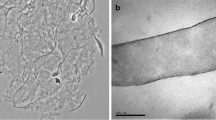Abstract
An extremely thermophilic, obligately anaerobic, sulphur-metabolizing archaebacterium of the order Thermococcales, previously isolated from a thermal pool at Kuirau Park, Rotorua, New Zealand, partially described, and designated isolate ANI, Thermococcales was further characteized. The isolate was a regular coccus of 0.5–2.0 mm in diameter, was strictly anaerobic, chemoorganotrophic, and fermentative. Peptone, yeast extract, or casein served as carbon and nitrogen source, and a variety of amino acids and glucose, but not organic acids, carbohydrates, or other sugars supported growth in the presence of peptone (0.1%). Major metabolic end products were H2, sulphide, acetate, isobutyrate, and isovalerate/2-methylbutyrate. Isolate ANI had a temperature optimum of 75–80°C, a pH optimum of 7.4, and a sodium chloride concentration optimum of 50mM. No growth was observed in the absence of sodium chloride (or lithium chloride) and sulphur (or cystine or oxidized glutathione).
Similar content being viewed by others
References
Bonch-Osmolovskaya EA, Slesarev AI, Miroshnichenko ML, Svetlichnaya TP, Alexeev VA (1988) Characterization of Desulfurococcus amylolyticus n. sp. A new extremely thermophilic archaebacterium isolated from thermal springs of Kamchatka and Kunashir Island. Microbiology (translation of Mikrobiologiya) 57:78–85
Bonch-Osmolovskaya EA, Miroshnichenko ML, Kostrikina NA, Chernych NA, Zavarzin GA (1990) Thermoproteus uzoniensis sp. nov., a new extremely thermophilic archaebacterium from Kamchatka continental hot springs. Arch Microbiol 154: 556–559
De Rosa M, Gambacorta A (1988) The lipids of archaebacteria. Prog Lipid Res 27:153–175
De Rosa M, Gambacorta A, Trincone A, Basso A, Zillig W, Holz I (1987) Lipids of Thermococcus celer, a sulfur-reducing archaebacterium: structure and biosynthesis. System Appl Microbiol 9:1–5
Fiala G, Stetter KO (1986) Pyrococcus woesei represents a novel genus of marine heterotrophic archaebacteria growing optimally at 100°C. Arch Microbiol 145:56–61
Janssen PH, Harfoot CG (1990) Isolation of a Citrobacter species able to grow on malonate under strictly anaerobic conditions. J Gen Microbiol 136:1037–1042
Lanzotti V, Trincone A, Nicolaus B, Zillig W, De Rosa M, Gambacorta A (1989) Complex lipids of Pyrococcus and ANI, thermophilic members of archaebacteria belonging to Thermococcales. Biochim Biophys Acta 1004:44–48
Marmur J, Doty P (1962) Determination of the base composition of deoxyribonucleic acid from its thermal denaturation temperature. J Mol Biol 5:109–118
Miroshnichenko ML, Bonch-Osmolovska EA, Neuner A, Kostrkina NA, Chernych NA, Alekseev VA (1989) Thermococcus stetteri sp. nov., a new extremely thermophilic marine sulfurmetabolizing archaebacterium. System Appl Microbiol 12: 257–262
Moench TT, Zeikus JG (1983) An improved preparation method for a titanium(III) media reductant. J Microbiol Methods 1: 199–202
Morgan HW, Daniel RM (1982) Isolation of a new species of sulphur-reducing extreme thermophile (abstract). Proceedings of the 13th International Congress of Microbiology (ASM) P20,1:86
Neuner A, Jannasch H, Belkin S, Stetter KO (1990) Thermococcus litoralis sp. nov.: a new species of extremely thermophilic marine archaebacteria. Arch Microbiol 153:205–207
Patel BKC, Morgan HW, Daniel RM (1985) Fervidobacterium nodosum gen. nov. and sp. nov., a new chemoorganotrophic caldoactive, anaerobic bacterium. Arch Miorobiol 141:63–69
Sambrook J, Fritsch EF, Maniatis T (1989) Molecular cloning. A laboratory manual, 2nd edn. vol 3. Cold Spring Harbor Laboratory Press, Cold Spring Harbor, E.3–E.4
Trüper HG, Schlegel HG (1964) Sulphur metabolism in Thiorhodaceae I. Quantitative measurements on growing cells of Chromatium okenii. Antoine Van Leeuwenhoek 30:225–238
Weatherburn MW (1967) Phenol-hypochlorite reaction for determination of ammonia. Anal Chem 8:971–974
Wolin EA, Wolin MJ, Wolfe RS (1963) Formation of methane by bacterial extracts. J Biol Chem 238:2882–2886
Zeikus JG, Hegge PW, Anderson MA (1979) Thermoanaerobium brockii gen. nov., sp. nov., a new chemoorganotrophic, caldoactive, anaerobic bacterium. Arch Microbiol 122:41–48
Zillig W, Holz I, Schäfer W, Reiter WD (1983) The archaebacterium Thermococcus celer represents a novel genus within the thermophilic branch of the archaebacteria. System Appl Microbiol 4:88–94
Zillig W, Holz I, Klenk H-P, Trent J, Wunderl S, Janekovich D, Imsel E, Haas B (1987) Pyrococcus woesei, sp. nov., an ultrathermophilic marine archaebacterium, representing a novel order, Thermococcales. System Appl Microbiol 9:62–70
Author information
Authors and Affiliations
Corresponding author
Rights and permissions
About this article
Cite this article
Klages, K.U., Morgan, H.W. Characterization of an extremely thermophilic sulphur-metabolizing archaebacterium belonging to the Thermococcales. Arch. Microbiol. 162, 261–266 (1994). https://doi.org/10.1007/BF00301848
Received:
Accepted:
Issue Date:
DOI: https://doi.org/10.1007/BF00301848




